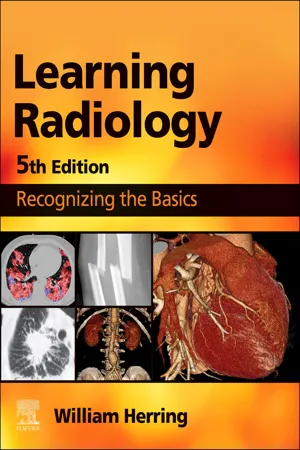
- English
- ePUB (mobile friendly)
- Available on iOS & Android
About this book
Dr. William Herring's Learning Radiology: Recognizing the Basics, 5th Edition, remains the leading introductory radiology text for medical students and others who are required to read and interpret common radiologic images. Using an easy-to-follow pattern recognition approach, this clearly written, highly illustrated text teaches how to differentiate normal and abnormal images of all modalities. From the basics of patient safety, dose reduction, and radiation protection to the latest information on ultrasound, MRI, and CT, it provides a complete, up-to-date introduction to radiology needed by today's students.- Uses a clear, conversational writing style—with a touch of humor—to explain what you need to know to effectively interpret medical images of all modalities.- Teaches how to arrive at a diagnosis by following a pattern recognition approach, and logically overcome difficult diagnostic challenges with the aid of decision trees.- Employs an easy-to-read, bullet-point format, including bolded key points and icons designating special content: Diagnostic Pitfalls, Really Important Points, Take-Home Points, and Weblinks.- Features more than 850 high-quality illustrations, useful tables, case study questions, and teaching boxes throughout.- Shares the extensive knowledge and experience of esteemed author Dr. William Herring, a skilled radiology teacher and the host of his own specialty website, www.learningradiology.com.- Offers quick review and instruction for medical students, residents, and fellows, as well as those in related fields such as nurse practitioners and physician assistants.
Frequently asked questions
- Essential is ideal for learners and professionals who enjoy exploring a wide range of subjects. Access the Essential Library with 800,000+ trusted titles and best-sellers across business, personal growth, and the humanities. Includes unlimited reading time and Standard Read Aloud voice.
- Complete: Perfect for advanced learners and researchers needing full, unrestricted access. Unlock 1.4M+ books across hundreds of subjects, including academic and specialized titles. The Complete Plan also includes advanced features like Premium Read Aloud and Research Assistant.
Please note we cannot support devices running on iOS 13 and Android 7 or earlier. Learn more about using the app.
Information
Table of contents
- Instructions for online access
- Cover image
- Title page
- Table of Contents
- Copyright
- Dedication
- Contributors
- Preface
- Acknowledgments
- 1. Recognizing Anything: Past, Present, and Future
- 2. Recognizing Normal Pulmonary Anatomy
- 3. Recognizing Normal Cardiac Anatomy
- 4. Recognizing Airspace Versus Interstitial Lung Disease
- 5. Recognizing the Causes of an Opacified Hemithorax
- 6. Recognizing Atelectasis
- 7. Recognizing a Pleural Effusion
- 8. Recognizing Pneumonia
- 9. Recognizing the Correct Placement of Lines and Tubes and Their Potential Complications: Critical Care Radiology
- 10. Recognizing Other Diseases of the Chest
- 11. Recognizing Adult Heart Disease
- 12. Recognizing the Normal Abdomen and Pelvis: Conventional Radiographs
- 13. Recognizing the Normal Abdomen and Pelvis: Computed Tomography
- 14. Recognizing Bowel Obstruction and Ileus
- 15. Recognizing Extraluminal Air in the Abdomen
- 16. Recognizing Abnormal Calcifications and Their Causes
- 17. Recognizing Gastrointestinal, Hepatobiliary, and Urinary Tract Abnormalities
- 18. Ultrasonography: Understanding the Principles and Its Uses in Abdominal and Pelvic Imaging
- 19. Vascular, Pediatric, and Point-of-Care Ultrasound
- 20. Magnetic Resonance Imaging: Understanding the Principles and Recognizing the Basics
- 21. Recognizing Nontraumatic Abnormalities of the Appendicular Skeleton and Arthritis
- 22. Recognizing Nontraumatic Abnormalities of the Spine
- 23. Recognizing Trauma to the Bony Skeleton
- 24. Recognizing the Imaging Findings of Trauma to the Chest
- 25. Recognizing the Imaging Findings of Trauma to the Abdomen and Pelvis
- 26. Recognizing Some Common Causes of Intracranial Pathology
- 27. Recognizing Pediatric Diseases
- 28. Using Image-Guided Interventions in Diagnosis and Treatment (Interventional Radiology)
- 29. Recognizing the Findings in Breast Imaging
- e-Appendix A. Nuclear Medicine: Understanding the Principles and Recognizing the Basics
- e-Appendix B. The ABCs of Heart Disease
- e-Appendix C. Radiation Dose and Safety
- e-Appendix D. Key Terminology and Glossaries
- e-Appendix E. Early History and Public Exuberance of the Discovery of X-rays
- e-Appendix F. Diagnostic Radiology Signs
- e-Appendix G. Artificial Intelligence and Radiology
- e-Appendix H. What to Order When
- Bibliography
- Index